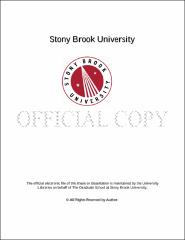| dc.identifier.uri | http://hdl.handle.net/11401/77576 | |
| dc.description.sponsorship | This work is sponsored by the Stony Brook University Graduate School in compliance with the requirements for completion of degree. | en_US |
| dc.format | Monograph | |
| dc.format.medium | Electronic Resource | en_US |
| dc.language.iso | en_US | |
| dc.publisher | The Graduate School, Stony Brook University: Stony Brook, NY. | |
| dc.type | Dissertation | |
| dcterms.abstract | The soft tissues of the volar surfaces of primate hands and feet are the primary point of interaction between an individual animal and its environment and, as such, are likely to be under strong functional selection. These tissues serve three major functions: 1) force attenuation – the volar fat pads assist in attenuating reaction forces generated during grasping locomotion; 2) friction enhancement – the volar fat pads also act as viscoelastic surfaces that increase the coefficient of friction between the pads and substrate at low body weights; in addition, the ridged volar skin interlocks with and thus increases friction with the substrate; and 3) tactile sensation – the tactile organs located in the volar skin receive and transmit information about the environment to the brain. The size and shape of the volar pads and skin have been shown previously to influence their ability to attenuate forces and produce friction at different body sizes and the morphology of the volar skin has been linked to differences in tactile acuity. Despite this clear, intuitive link between the morphology of the volar surfaces and locomotor and sensory adaptations, there has been relatively little formal analysis describing the nature of these relationships. The overarching goal of this dissertation research is, therefore, to describe and quantify the morphology of the volar pads and skin in strepsirrhine primates. Proposed relationships of the volar morphology to dietary preferences, locomotor regimes, substrate use, body size, and bony morphology are explored. Adaptations related to friction grasping at different body sizes and utilizing different modes of locomotion account for most of the variation present in both the volar pads and skin; variation relating to different force attenuation regimes is not evident in this sample. Some evidence is found for a link between tactile acuity, diet, and morphological adaptation of the volar skin, but this is preliminary and requires additional work. | |
| dcterms.abstract | The soft tissues of the volar surfaces of primate hands and feet are the primary point of interaction between an individual animal and its environment and, as such, are likely to be under strong functional selection. These tissues serve three major functions: 1) force attenuation – the volar fat pads assist in attenuating reaction forces generated during grasping locomotion; 2) friction enhancement – the volar fat pads also act as viscoelastic surfaces that increase the coefficient of friction between the pads and substrate at low body weights; in addition, the ridged volar skin interlocks with and thus increases friction with the substrate; and 3) tactile sensation – the tactile organs located in the volar skin receive and transmit information about the environment to the brain. The size and shape of the volar pads and skin have been shown previously to influence their ability to attenuate forces and produce friction at different body sizes and the morphology of the volar skin has been linked to differences in tactile acuity. Despite this clear, intuitive link between the morphology of the volar surfaces and locomotor and sensory adaptations, there has been relatively little formal analysis describing the nature of these relationships. The overarching goal of this dissertation research is, therefore, to describe and quantify the morphology of the volar pads and skin in strepsirrhine primates. Proposed relationships of the volar morphology to dietary preferences, locomotor regimes, substrate use, body size, and bony morphology are explored. Adaptations related to friction grasping at different body sizes and utilizing different modes of locomotion account for most of the variation present in both the volar pads and skin; variation relating to different force attenuation regimes is not evident in this sample. Some evidence is found for a link between tactile acuity, diet, and morphological adaptation of the volar skin, but this is preliminary and requires additional work. | |
| dcterms.available | 2017-09-20T16:52:56Z | |
| dcterms.contributor | Larson, Susan G | en_US |
| dcterms.contributor | Demes, Brigitte | en_US |
| dcterms.contributor | Kley, Nathan J | en_US |
| dcterms.contributor | Susman, Randall L | en_US |
| dcterms.contributor | Muchlinski, Magdalena N. | en_US |
| dcterms.creator | Kingston, Amanda Kathryn | |
| dcterms.dateAccepted | 2017-09-20T16:52:56Z | |
| dcterms.dateSubmitted | 2017-09-20T16:52:56Z | |
| dcterms.description | Department of Anthropology | en_US |
| dcterms.extent | 198 pg. | en_US |
| dcterms.format | Application/PDF | en_US |
| dcterms.format | Monograph | |
| dcterms.identifier | http://hdl.handle.net/11401/77576 | |
| dcterms.issued | 2016-12-01 | |
| dcterms.language | en_US | |
| dcterms.provenance | Made available in DSpace on 2017-09-20T16:52:56Z (GMT). No. of bitstreams: 1
Kingston_grad.sunysb_0771E_12833.pdf: 4875801 bytes, checksum: 28a67f800f4c4ea74a2b279847f14d9e (MD5)
Previous issue date: 1 | en |
| dcterms.publisher | The Graduate School, Stony Brook University: Stony Brook, NY. | |
| dcterms.subject | dermatoglyphics, finger prints, preservation, volar pads, volar skin, volar surface | |
| dcterms.subject | Physical anthropology | |
| dcterms.title | The Macro- and Micro-anatomy of Primate Volar Surfaces | |
| dcterms.type | Dissertation | |

